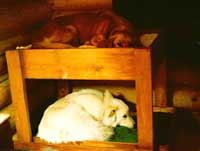The term "positive reinforcement" is used a lot in training. The idea is that your dog (or cat!) is motivated by a reward to do whatever it is you want it to do. I tend to think of it as the "what’s in it for me" approach to training. If your pet has a worthwhile reason to do something, he will do it. If you can figure out what it is that motivates your pet, positive reinforcement can be a powerful way to shape or change behavior.
Timing is the key to using positive reinforcement in training. You have to give the pet the reward at the exact instant he’s doing the right thing, or the pet can associate the wrong action with the reward. For example, if you tell your dog to "sit" and then he slumps into a "down" and you give him the treat, he’ll think he’s being rewarded for the "down." (Ooops!) Only reward the good behavior, not the bad. This caveat is why so many dogs continue to bark even after being told not to. For some dogs, any attention is better than no attention. When he barks, you yell. The dog views you yelling as a good thing, thus reinforcing the behavior. (Another oops.)
The tricky part in using positive reinforcement as a tool is that you must find out what motivates YOUR pet. For example, I have three dogs and they are motivated by three different things. Cami is motivated by food. If I have a treat, she’s the ultimate obedient model citizen; if I don’t, she couldn’t care less what I say. Tika is sensitive to touch. Petting her makes her extremely happy (sometimes too happy). Food didn’t work well for motivation, especially when she was young because she couldn’t focus long enough to eat. Leia is sensitive to tone of voice. A happy praising voice is a thrill for her, and she wags her tail almost every time. Some dogs are also motivated by play. Many drug dogs are trained with a short play session as a reward for finding something, and trained cats such as the ones in TV commercials are almost invariably trained using food.
All dogs and cats are individuals. Experiment to find out what motivates your pet, and keep training sessions short and happy. Once your pet figures out what’s in it for him, he’ll be happy to do what you want.

After a little positive reinforcement training, Cami (lower) and Tika (upper) love their bunk bed.